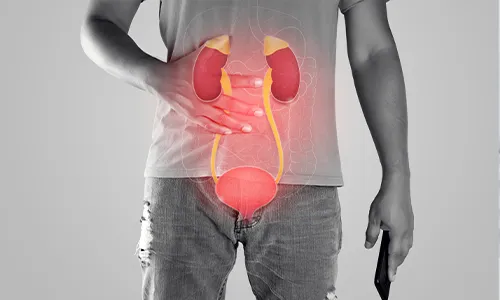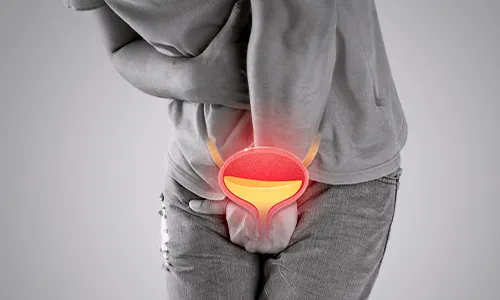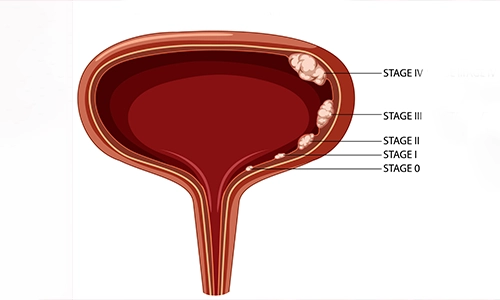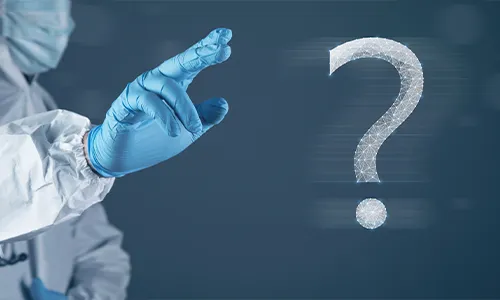

About Bladder cancer
Bladder cancer develops when the cells that compose the urinary bladder start to proliferate uncontrollably. A tumor can emerge when multiple new cancer cells grow; over time, that tumor may spread to other areas of the body.


Risk Factors & Prevention
Almost 70% of Bladder cancer patients are over the age of 65. Bladder cancer is four times more common in men than in women.
Some risk factors are:
- Use of Tobacco / Smoking
- Previous pelvic radiation therapy
- Persistent bladder infection
- Use of Cyclophosphamide
- Use of Pioglitazone
- People with lynch syndrome and other genetic syndromes
- Exposure to Arsenic
How can it be prevented?
- Quit Smoking
- Limited exposure to chemicals
- High intake of fluids
- Healthy diet


Screening
No prominent professional groups now advocate routine public screening for Bladder cancer.
Potential screening procedures for Bladder cancer are:
- Urinalysis
- Urine cytology
- Urine tests for tumor marker
- Ultrasound


Symptoms & Signs
- Urinary blood or blood clots
- When urinating, feeling pain or burning sensation
- Frequent urge to urinate
- Having the urge to urinate but being unable to do so
- Lower back discomfort on one side of the body


Diagnosis
Bladder cancer diagnostic tests determine whether you have the disease and how aggressive it may be.
Tools and tests include:
- Cystoscopy
- Biopsy/Transurethral resection of bladder tumor (TURBT)
- Biomarker
- CT or CAT scan
- MRI
- Bone scan
- PET-CT scan
- Ultrasound


Sub-Types and Stages
Noninvasive, non-muscle-invasive, or muscle-invasive
Bladder cancer are all possible groupings:
- Urothelial carcinoma
- Squamous cell carcinoma
- Adenocarcinoma
- Sarcomatoid carcinoma of the bladder
- Small cell Bladder cancer
Stages
Stage 0:
Cancer is only present in the inner layer of the bladder lining, OR the inner layer only contains very early high-grade cancer cells which have not invaded the bladder lining.
Stage 1:
The connective tissue under the bladder lining has become infiltrated by the malignancy.
Stage 2:
Cancer has spread into the bladder wall muscle through the connective tissue layer.
Stage 3:
Cancer has spread to the prostate, womb, or vagina after bursting through the muscle and into the fat layer. Additionally, it might have affected adjacent lymph nodes.
Stage 4:
Cancer has spread to distant lymph nodes and bodily organs such as the bones, lungs, or liver.


Treatment Modalities
a. Surgical Oncology
A few of the prominent surgical options for treating Bladder cancer:
- Transurethral bladder tumor resection (TURBT) – Removes the tumor using a tool called fulguration.
- Radical cystectomy and lymph node dissection – Removing the whole bladder and any adjacent affected tissues or organs.
b. Medical Oncology
- Intravesical chemotherapy (Chemotherapy in the bladder) – Used to treat cancers that are limited to the bladder’s lining but are at high risk of returning or progressing to a more advanced stage.
- Systemic chemotherapy (Chemotherapy for the whole body) – Used as a primary treatment when surgery is not an option or to increase the likelihood of a cure in patients having surgery to remove the bladder.
- Immunotherapy – Activating the body’s defenses against cancer cells, whether they are in the bladder or elsewhere in the body.
- Targeted therapy – Used to treat advanced cancer.
c. Radiation Oncology
- Typically, a machine that moves around your body delivers radiation therapy for Bladder cancer by aiming energy beams at specific locations.


Coping with Treatment
Along with the medical side effects of Bladder cancer therapy, patients also deal with the financial burden of cancer care and the emotional and social impacts. MOC provides facility of psycho Onco-Counseling and Nutritional counseling to help patients.


Do’s & Don’ts During Treatment
Do’s
- Maintain a well-balanced diet
- Consume adequate protein sources
- Eat every 2 to 3 hours
- Drink plenty of water
Don’ts
- Avoid overexertion


Post-Treatment Support
Post-treatment Bladder cancer survivors can undergo long-term side effects of surgery, radiation therapy, chemotherapy, and hormonal therapy. They can also have symptoms such as High-frequency hearing loss and tinnitus, low blood counts, nausea, and vomiting. Survivors require empathy, mental strength, and support from their families. They can also join Bladder cancer Post-Treatment Survivorship Support Groups.


Follow-ups Cancer Care Plan
Post-treatment, one must request a follow-up treatment plan. Doctors provide a personalized treatment plan based on the type and stage of cancer.


Surveillance and monitoring for Signs & Symptoms of Recurrence
One aim of follow-up care is checking for a recurrence, and one should never miss follow-up visits and never ignore any symptoms of recurrence. Because some cancer cells may remain undiscovered in the body in small locations that don’t respond to treatment, cancer can reoccur. A physician knowledgeable about your medical history can provide personalized information regarding your risk of recurrence during follow-up care.


FAQ's
-
What are my treatment options for Bladder cancer?
The types and stages of cancer determine the therapy options.
-
Having my surgery done robotically would be beneficial?
The results are the same whether the surgery was performed open or robotically.
-
Are Bladder cancer symptoms different in women than in men?
No, In general, women and men experience the same symptoms of Bladder cancer.
Specialized Doctors at M | O | C
Find the nearest center
Cancer Centres
Mumbai
Pune
Rest of Maharashtra
Gujarat
Delhi NCR
Cancer Clinics
Borivali
+91 9920767626
Book Your Appointment




























.png)









.png)




















.png)
.png)
.png)



